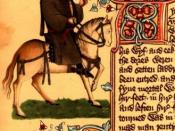In ChaucerÃÂs section of the Canterbury Tales, ÃÂThe Pardoners TaleÃÂ various literary elements occur. He displays personification, and makes death a character, giving him life. He includes a moral to his tale which is ÃÂgreed is the root of all evilÃÂ(Bible) and gives the story meaning. ChaucerÃÂs plot is another key part to the story, because it proved greed can bring evil. Chaucer wrote the ÃÂPardoners TaleÃÂ with the theme ÃÂgreed is the root of all evilÃÂ he was able to show this by using various literary elementsThe moral, ÃÂgreed is the root of all evilÃÂ(Bible), is displayed through the greediness of the three characters. When the youngest leaves, his mind was able to devise an evil plan caused by greed. His selfishness caused him to do the following, ÃÂAnd deftly poured the poison into two. He kept the third one clean, as well he might, For his own drink, meaning to work all nightÃÂ(Chaucer 217-218).
The youngest was tempted by greed to commit an evil action. Chaucer wanted the reader to realize money and greed are problems with society. They cause people to commit evil acts. Killing someone for money shows Chaucer wanted one to read this tale and recognize the problems of greed.
The Characters are essential to this tale also. Chaucer displays death as a character giving him human traits and personifying him. This personification of death adds a sense of doom and gives a slight fear. Death adds these qualities because dying is like a journey to the unknown, and it naturally scares people to think about it. When Chaucer writes, ÃÂThere came a privy thief, they call him Death, Who kills us all round hereÃÂ ÃÂ(Chaucer 15-16) he attempts to add a sense of fear and terror by saying there is a person...


